What is Simple Random Sampling (SRS)?
The techniques of statistical sampling provide the essential structure for empirical research, granting scholars the ability to reach insightful conclusions about large populations without the need to examine each case.
Among various sampling techniques available, the Simple Random Sampling (SRS) is the most basic and well-known in the field of statistics.
This post focuses on the concepts, relevance, and application of SRS in current research. With the exploration of equal probability of selection for each member of the population, we justify the claim of unbiased data collection in the framework SRS. The discussion addresses SRS from the practical point of view and covers its implementation from simple lottery to sophisticated computer algorithms while emphasising SRS as a tool for statistical validity in research ranging from social and health sciences to marketing.
Table of Contents
Meaning of Simple Random Sampling
Simple random sampling is a type of probability sampling in which every member of a population has an equal chance of being selected for the sample. This is the most straightforward type of probability sampling, and it is often used in research studies to ensure that the sample size is representative of the population.
Here are some examples of simple random sampling:
- A researcher wants to study the attitudes of students at a large university towards a new tuition policy. The researcher creates a list of all students at the university and then uses a random number generator to select a sample of students to survey.
- A marketing company wants to study the effectiveness of a new advertising campaign. The company creates a list of all customers who have been exposed to the campaign and then uses a random number generator to select a sample of customers to survey.
- A public health official wants to study the prevalence of a disease in a community. The official creates a list of all residents of the community and then uses a random number generator to select a sample of residents to test for the disease.
To conduct a simple random sample, you will need to have a list of all members of the population. You can then use a random number generator to select a subset of members from the list. For example, if you have a population of 100 people and you want to select a sample of 20 people, you would use a random number generator to select 20 unique numbers between 1 and 100. The people who correspond to those numbers would be your sample.
The objective of Simple Random Sampling
SRS is a random sampling method to collect data. The researcher would randomly select the sample from the population group. The objective of SRS is to sample a finite number of units randomly from a population according to a sampling scheme (a simple uniform or multistage scheme)
The method begins with the selection of the area or the population. Then a sampling frame is used to select a sample. In its simplest form, households are selected from the sampling frame, and each household is assigned a weight according to the number of people residing there. The individual weights are added up, and the final weight is used to represent the original population. The final weighted sample is the representative sample from which you draw your inference.
Equivalently, one may make a sequence of independent selections from the whole population, each unit having an equal probability of selection at each step, discarding repeat selections and continuing until n distinct units are obtained.
A simple random sample of n = 3 units from a population of N = 24 units is depicted in the Figure below:

In the above image, there are a total of 24 circles representing the total population or sample size. Three circles are randomly selected, marked in orange colour. The samples are shown in the right-hand box.
Designs other than simple random sampling may give each unit an equal probability of being included in the sample. But with simple random sampling, each possible sample of units has the same probability.
SRS will generate a representative sample of the population. The procedure will not favour one subgroup over another. SRS will not choose a representative sample from this population. There is no systematic individual selection. The sample selection is random, implying that there is no control over who is chosen. All people have an equal chance of getting picked for a sample. This is significant since SRS does not make hiring decisions based on demographic factors such as age or race.
Also Read: What are the 5 Modern Ways to Collect Primary Data?
Advantages of Simple Random Sampling
Among the advantages of simple random sampling is the simplicity of sample assembly. It is also regarded as a fair or unbiased method for selecting a sample from a particular population because each member has an equal chance of being chosen.
The representativeness of a simple random sample is another important characteristic. Luck is the only theoretical factor that could damage its representativeness. The random variance if the sample is not representative of the population is known as sampling error.
Conclusions drawn from a study’s results must be based on an impartial random selection and a representative sample. Remember that one of the purposes of research is to draw population-level inferences from the results of a sample. Due to the representativeness of a sample acquired through simple random sampling, it is feasible to extrapolate the sample’s findings to the entire population.
Disadvantages of Simple Random Sampling
Simple random sampling is a powerful tool for ensuring that a sample is representative of a population, but it has some limitations. Here are some of the most common limitations:
Time-consuming and expensive to implement. This is especially true for larger populations or populations that are spread out geographically.
Difficult to obtain a list of all members of a population. This is especially true for hidden populations, such as people who are homeless or people who are involved in illegal activities.
Sampling errors. This occurs when the sample is not representative of the population. For example, if you are studying the attitudes of students at a large university and your sample only includes students from one particular department, then your results may not be generalizable to the entire student population.
Simple random sampling can be inefficient. In some cases, it may be more efficient to use a different sampling method, such as stratified sampling or cluster sampling. In short, the simple random sampling technique is prone to many limitations that may lead to choosing wrong samples and wrong outcomes.
Conclusion
Simple Random Sampling is the most basic sampling method. If you have ever utilised a random number generator, you have performed SRS. Random sampling is also known as a ‘simple random sample’ or’simple random selection,’ and it is used whenever objects from a population must be sampled. For instance, while attempting to determine how many members of a specific kind (group) of items are present in a group of objects.

